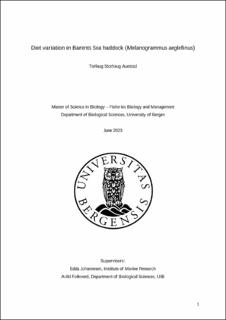| dc.description.abstract | Diet composition and feeding are crucial for assessing fish species ecological role, population dynamics, and overall ecosystem health. It provides insights into fish’s functional role within the food web, and it contributes to their energy acquisition, overall survival, growth, and reproductive success. Barents Sea haddock (Melanogrammus aeglefinus) is an important commercial species in the Barents Sea, but there are few comprehensive studies and documentation on haddock stomach contents. This study aims to address this gap by utilizing haddock stomach data from 1984 to 2019, providing an overview of the haddock diet. Additionally, the year 2009 was studied in detail to explore the geographic variation diet composition and feeding success of Barents Sea haddock. To test for competition, the effect of density of haddock on the proportion of empty stomachs and the Total Fullness Index (TFI) was analyzed. For all years, the main prey categories found in haddock stomachs were Crustacea and Echinodermata. However, in 2009, the dominant prey category was Annelida. A significant difference was observed in the proportion of empty stomachs among the different areas in the Barents Sea, with the southwest having more empty stomachs compared to the southeast and northwest. The prey categories Annelida, Mollusca, and Crustacea were most found in the southeast, while Echinodermata was more prevalent in the northwest. As the size of haddock increased, the probability of empty stomachs decreased, with the southwest area having the highest probability. Additionally, larger haddock had a higher likelihood of containing Annelida, Mollusca, and others prey types in their stomachs. In the southeast area, there was a significant negative effect of haddock density on stomach fullness. My research contributes to a better understanding of haddock diet and address knowledge gaps about the Barents Sea haddock population where information on stomach content has been lacking. Improved knowledge of their diet is crucial for future management and conservation efforts. | |
